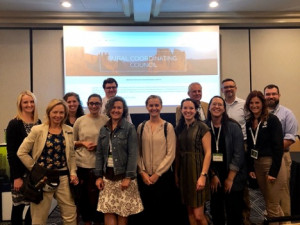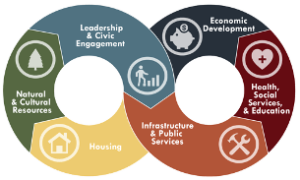Breaking Down Silos: The Inception of the Utah Rural Coordinating Council
June 4, 2021 by admin
Rural Planning
The term “breaking down silos” has been around for a while now, but what does that actually look like? Are we building tin can telephones from silo to silo? Using sledgehammers and pickaxes to construct tunnels? Or are we just waiting for the Big Bad Wolf to blow it all down?
The Community Development Office (CDO) within Utah’s Department of Workforce Services, as a statewide organization that supports rural Utah, recognizes that we’re just one of many service providers. From federal agencies to nonprofits and more, there are a myriad of individuals, organizations, and initiatives with relationships and resources aimed at rural Utah. Yet how does it all connect? Should it all connect? Who is orchestrating this symphony of services in a way that’s efficient for service providers and streamlined for communities? Is it even possible to do so?
When I joined Utah’s Community Development Office in the summer of 2018, I came across a dream project that my new colleagues had been envisioning for several years. The dream was to unite Utah’s rural service providers so that each could use their unique talents and resources to better support rural Utah in a coordinated fashion; almost like the Avengers of Rural Utah, yet the question remained, what will bring everyone together? What will make people want to participate?
The Inception of the Rural Coordinating Council
The idea came from an exploratory meeting in the fall of 2018 to discuss the topic of reintroducing the Main Street America program to Utah, which included 40+ rural service providers all from different organizations! That’s it, we thought, Main Street is the hook.
We hosted a follow-up gathering on December 4, 2018, with attendees from agencies, universities, nonprofits, and more. We met at the Utah State Capitol, as I felt that the location elevated the launch and served as a neutral space. The last thing I wanted attendees to think was that this was a Community Development Office project; we were launching it, yes, but truly, it belonged to everyone.
That kickoff was one filled with excitement and nervousness for me. I barely knew anyone, and worried that perhaps people wouldn’t be interested in what I was proposing or think that I was too inexperienced to lead something like this. After all, I had only been in the state for five months. What did I know about rural Utah and leading a statewide initiative?
The moment it all felt real and even possible was when we went around the room with introductions. Glancing at each attendee and learning of where they work and what they do started to weave together this tapestry of resource diversity; individuals in rural health, energy development, tourism, infrastructure, arts, education, and more. All at one table. All working in rural Utah.
I explained our office’s comprehensive community development framework, which highlights how each element shown (in the graph below) affects and is affected by one another. While it seems we may be doing completely unrelated work, it’s actually all related. One initiative affects another, over and over again, emphasizing the importance of increased cross-level communication and collaboration.
We spent our kickoff gathering discussing the possibilities of what the RCC could look like. The conversations that erupted from these prompts were rich in depth, experience, and insights. It felt right to have so many of us in one room together and it began to paint a more holistic view of what projects were taking place across the state.
Establishing the Framework for the Utah Rural Coordinating Council
After a follow-up survey was distributed to attendees, we were able to define our structure. RCC members wanted:
-To gather together quarterly for an hour and a half and share updates on projects and brainstorm challenges and opportunities;
-To focus on building strong working relationships with one another;
-To rotate locations, so that we could experience other’s work environments; and
-To not have a steering committee, but instead, have a central coordinator
Together, we develop annual goals that focus on increasing our capacity. While we only gather four times a year, we do form working groups for members to meet on a more regular basis. Since Main Street was the impetus for the RCC, we formed our first working group on that topic. A group of RCC members started gathering together regularly to look at what a Main Street program could look like in the state, and eventually piloted a program in both Brigham City and Price City. Just within this last legislative session, due to those efforts and more, our state legislature funded S.B.194, which provides both one-time and annual funding to launch an official Main Street Utah Program. It’s quite remarkable that the impetus for the RCC has evolved into legislation and that just speaks to the passion and drive of our members.
Most members from the Utah Rural Coordinating Council are line workers, meaning that we are not necessarily directors, but we all interact with the same elected and appointed officials throughout the state. Many of us have had to ask for permission to allow ourselves to be a part of this initiative, and we are limited by our decision-making power at times. The beauty of this, though, is that every single member is a part of the RCC, because they want to be. It’s as grassroots as it gets, and I think that’s what has made it so successful so far.
What has the Utah Rural Coordinating Council accomplished so far?
I’d say our first accomplishment is that we still exist! The first two years of this initiative were actively spent forming a solid foundation that would carry on past myself and others that may eventually lead the RCC. The sustainability aspect to this initiative is vital. I’ve constantly thought about the longevity of the RCC and how we can ensure that people will want to be involved for the long-term.
We have also collaborated with the American Planning Association Utah Chapter and the Utah League of Cities & Towns for several conferences. Through the creativity of our members, our first collaborative presentation involved a spin-off of Mr. Rogers’ Neighborhood. We were also invited to meet with former Lt. Governor Spencer Cox to discuss our initiative and receive his support, and were interviewed by Strong Towns through their It’s the Little Things podcast series.
Since the inception of the Utah Rural Coordinating Council, I’ve always asked us two questions: (1) what does everyone offer to rural Utah? and (2) where is everyone working in rural Utah?
As service providers, we know what our organizations offer, but what of others? We decided to tackle the first question by crafting a Utah Technical Planning Assistance Inventory that includes 200+ resources for Utah communities.
Challenges and Benefits to the Utah Rural Coordinating Council
Before the COVID-19 pandemic, the size of the RCC was actively on my mind. As I kept identifying how many service providers work in rural Utah, I kept wondering how big we would become. Could we eventually become too big to function? I still wonder that, honestly. However, with shifting to online platforms, we’ve now been able to reach an audience that extends beyond the Salt Lake City metropolitan area. Zoom enables us to host a plethora of attendees and ensure that more service providers have a seat at the virtual table.
Are there individuals that should be a part of the RCC that are not? Absolutely. Every gathering, we typically have at least one new member. Our office has been able to hire an intern this year that is actively looking into who else has yet to be invited. Our members come from the public sector, higher education, and nonprofits, and provide services for the entire state. If you’re reading this article and you fit under that category, please reach out to us via our RCC Contact Form.
Additionally, because we are line workers, we don’t represent the organizations that we work for; we are members from 30+ organizations, not members of 30+ organizations. This is an important distinction, because our membership is voluntary and based on individuals, not organizations. This limits our ability to speak on behalf of our organizations, however, it still allows members to provide insights from each of their respective organizations.
What’s next on the Horizon for the Utah Rural Coordinating Council?
With two years under our belt, I truly believe that 2021 is a beautiful year for the RCC. We’ve established a solid foundation for ourselves and are now finally tackling larger projects that we’ve wanted to tackle since the very beginning, which include:
-Launching a RCC Tribal Working Group, which is beginning to connect RCC members to both the Utah Division of Indian Affairs and to the eight Sovereign Nations within the State of Utah
-Designing a RCC GIS Dashboard, which will geographically depict where we’re all working throughout the state. This will not only encourage greater communication between providers working in the same areas, but it will also allow us to better understand which counties and municipalities are not receiving services. From an equity standpoint, this will allow service providers with project flexibility to prioritize those communities first and ensure that resources are evenly distributed across the state.
The structure of the RCC will inevitably change to meet the needs of the current moment. Its grassroots nature provides enough flexibility to adapt while encouraging members to keep returning and working collaboratively. I’m grateful to each and every member of this initiative and for all that they do for rural Utah. If you have any insights, tips, or questions involving the Utah Rural Coordinating Council, please reach out to Jordan Katcher at jkatcher@utah.gov.
Jordan Katcher, MCRP is both a Community Development Specialist with the Utah Department of Workforce Services – Community Development Office and an Associate Instructor within the University of Utah’s City & Metropolitan Planning Department. She holds a Bachelor of Arts in Anthropology and English from the University of Virginia and a Master of Community & Regional Planning from the University of Oregon. She has also completed a 40 Hour Public Participation Training through the International Association of Public Participation (IAP2). To learn more about the Utah Rural Coordinating Council, please visit sites.google.com/utah.gov/rural
Breaking Down Silos: The Inception of the Utah Rural Coordinating Council
Recent News
- » APA UT- Call for Nominations
- » 2024 APA UT Spring Conference: Cedar City, UT. The Call For Sessions is Currently Open.
- » Planning In The News- Opinion: As a commuter who can’t afford to live in Salt Lake City, I still deserve to be heard
- » Hurry, it’s the final week to grab your conference tickets at regular prices!
- » Planning in the news: BYU students aim to eliminate parking woes through AI tracking system
- » Planning in the news: Living in Daybreak- What residents say the Utah community is really like



































